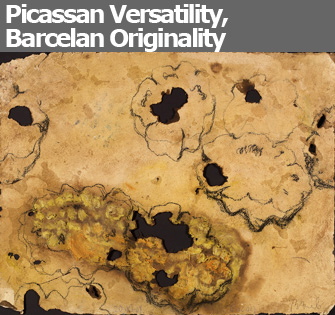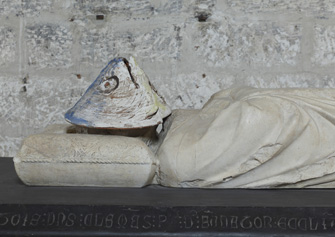 |
|
“Untitled” (2009), one of Miquel Barceló’s paintings on termite-eaten paper. © Miquel Barceló/ADAGP |
Miquel Barceló, like Pablo Picasso, is a natural-born artist, working with enormous ease, superhuman energy and great versatility. Just as Picasso could look at …
 |
|
“Untitled” (2009), one of Miquel Barceló’s paintings on termite-eaten paper. © Miquel Barceló/ADAGP |
Miquel Barceló, like Pablo Picasso, is a natural-born artist, working with enormous ease, superhuman energy and great versatility. Just as Picasso could look at the carcass of an old bicycle and fashion it into a brilliant goat so convincing (without being at all realistic) that it seems as if it’s about to bleat, Barceló is constantly transforming what he finds around him into something else.
That is not to say that Barceló is an imitator of Picasso in any way, however, although an echo or tribute might pop up here and there. Barceló is his own artist. His paintings are more sculptural than a two-dimensional, with the thickly applied pigments, often mixed with other substances, rippling into waves, gouged with little volcano- or flower-like eruptions, or standing out from the canvas in fragile, hair-like points. Many of his works seem to be almost alive and growing. He is equally at home with color or neutral shades, with abstraction and figuration, with monumental and miniature, with brutal and delicate treatments, with found and handmade objects. His materials might include whatever he finds at hand, from sand to donkey dung to smoke-damaged canvases.
For a thorough introduction to the work of this exciting artist, a trip to Avignon (never a chore) is in order. The city of popes is celebrating the artist with a three-part exhibition called “Miquel Barceló: Terra-Mare.” Barceló was born in Majorca and still has a home on the island but also lives and works for part of each year in Paris and Mali, hence the exhibition title’s references to earth (the very earthy works made in Mali) and the sea, a natural subject for an islander.
The one work no tourist will miss is the giant elephant poised upside-down on the tip of its trunk in the square in front of the Palais des Papes, but they will also find his sculptures in the Palais des Papes’ Grande Chapelle (an exhibition of Picasso’s paintings was staged there four years before the artist’s death); recent paintings and works on paper in the Collection Lambert; and a few paintings in the Musée du Petit Palais (home to a wonderful collection of Italian and School of Avignon paintings), which also has a marvelous small show of rarely seen Majorcan Gothic works, most of which are being shown outside of Spain for the first time.
Start with the Collection Lambert, a contemporary art museum in a handsome 18th-century town house, where each room shows a different aspect of the work of this prolific artist. Barceló’s versatility and inventiveness are amply demonstrated in room after room, beginning with abstract paintings (even though they might have titles like “Aubergines,” Barceló often looks at a work when it’s finished and then makes up a title to correspond to what it might possibly represent) on termite-eaten paper.
Monumental abstract/figurative paintings, some in brilliant colors and others monochromes, are followed by a room of haunting portraits of albinos Barceló met in Mali, where they are often viciously discriminated against. For these paintings, Barceló worked on black paper, removing its pigment with chlorine bleach. While most of his figurative works represent animals, his talent as a portraitist can also be seen in a few other works shown here.
In other rooms we find his sculptures, most of which began life as rough bricks or pots made using Neolithic techniques in a disused kiln he bought in Mali. He rehired its former employees, who know how to make only basic objects, with
 |
|
Miquel Barceló’s “Peix Blau” (1998) on the tomb of Pope Clement V in the Palais des Pape. © Miquel Barceló-ADAGP. Photo: Franck Couvreur |
no color or glazing. When inspired by a fault or break in one of them, Barceló might twist it into something else. A number of these sculptures can also be found in the Palais des Papes, juxtaposed with medieval sculptures.
Fame came early to Barceló, who was born in 1957. He was still a teenager and had already been included in a couple of group exhibitions when Joana Maria Palou, then an intern at the Museu de Mallorca, gave him a show consisting of boxes containing rotting meat and other substances (he was far ahead of his time; such shows are now commonplace). Palou is now the director of the same museum, which is currently closed for restoration, and has mounted a small exhibition of 13th and 14th-century Gothic works from Majorca at the Petit Palais that demonstrate
 |
|
Anonymous triptych of “Man of Sorrows” (c. 1400) from the Monastery of Santa Clara. |
the same kind of cross-fertilization of artistic currents we see in Barceló’s work – Majorcan artists traveled around Europe and brought back new influences, and the island also welcomed painters from Italy, Flanders and elsewhere.
The juxtaposition of Barceló’s works with historical pieces is less successful in the Petit Palais than it is in the Palais des Papes, where a fish-head sculpture, for example, takes the place of the missing head of a sepulchral sculpture. At the Petit Palais, only four of Barceló’s small termite-paper paintings are included, hung at one end of the room, and are overshadowed by the small and fascinating collection of paintings, ceramics and sculptures, many of them made at the time when Majorcan royalty paid a visit to the pope in Avignon, who supported the Majorcans against their rivals in Aragon.
Collection Lambert en Avignon, Musée d’Art Contemporain: 5, rue Violette, 84000 Avignon. Tel.: 04 90 16 56 20. Open Tuesday-Monday, 11am-6pm, September through June. Open Sunday-Friday, 11am-7pm and Saturday 11am-9pm in July-August. Admission: €7. www.collectionlambert.com
Musée du Petit Palais: Palais des Archevêques, Place du Palais des Papes, 84000 Avignon. Tel.: 04 90 86 44 58. Open October-May, 9:30 a.m.-1 p.m.; 2 p.m.-5:30 p.m.; June-September, 10 a.m.-1 p.m.; 2 p.m.-6 p.m. Closed Tuesdays, January 1, May 1, July 14, November 1 and December 25. www.petit-palais.org/
Palais des Papes: Place du Palais des Papes, 84000 Avignon. Tel.: 04 90 27 50 00. Open daily April-June, 9 a.m.-7 p.m.; July, 9 a.m.-9 p.m.; August-September, 9 a.m.-8 p.m.; October, 9 a.m.-7 p.m.; November-March, 9:30 a.m.-5:45 p.m. Admission: €9.50 (€11.50 includes admission to Pont Saint Bénezet). Reservation required for “Palais Secret” visit and brunch. www.avignon-tourisme.com or www.palais-des-papes.com
Order the catalogue Miquel Barceló: Terra-Mare from Paris Update’s Amazon store at no extra cost. Click on your preferred Amazon location: U.K., France
Support Paris Update by ordering books from Paris Update’s Amazon store at no extra cost. Click on your preferred Amazon location: U.K., France, U.S.
More reviews of Paris art shows.
Reader Reaction: Click here to respond to this article (your response may be published on this page and is subject to editing).
© 2010 Paris Update
Favorite